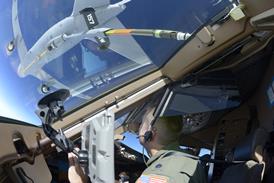Officials in Equatorial Guinea have indicated that a Boeing 737-800 arriving at Malabo in poor weather touched down long on the runway before it overran.
The Ceiba Intercontinental aircraft – carrying the Ethiopian registration ET-AWR – had arrived following a domestic service from Bata on 29 August.
Equatorial Guinea’s governmental information office, citing a representative of air navigation authority ASECNA at the capital Malabo airport, states that the aircraft encountered low-visibility conditions during its approach.
“As visibility was poor, the pilot asked for the intensity of the lights on the runway to be increased,” says the information office.
“Even so, the pilot could not see well enough.”
It adds that the aircraft had descended to a “critical” height, without elaborating on why the landing attempt was not aborted.
“Since the landing had started in the middle of the runway, it was already impossible to brake in time and it ended up off the runway,” the office states.
Malabo has a single runway, designated 04/22, which is 2,940m in length.

Photographs circulating on social media channels, purportedly showing the accident site, indicate that the aircraft came to rest on grass, with passengers evacuating via slides.
There are no reports of injuries from the accident. The extent of damage to the aircraft is unconfirmed, and no formal findings on the circumstances of the overrun have been released by investigators.
Meteorological data shows Malabo airport experienced reduced visibility and light rain during the afternoon, but the condition of the runway has yet to be disclosed.
The aircraft involved was originally delivered to Ceiba Intercontinental as 3C-LLY in 2014, but was subsequently transferred to Ethiopian Airlines management in 2019.
Ceiba Intercontinental, like all carriers from Equatorial Guinea, is subject to a blacklist ban by the European Commission.


























